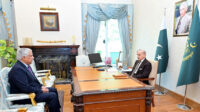The recent endeavour of meddling with the Article 35-A of the Indian Constitution has stirred up ire and agitations among the natives of Jammu-Kashmir. The fact of the matter is the removal of the Article 35-A will erode the state’s autonomy, whatever it has, and will weaken the grip of the natives (holding Permanent Resident Certificate (PRC)) on the rights, opportunities and privileges of the state. The privileges and rights, according to the Article 35-A, are not extendable, in any way, shape or form, to any non-permanent resident of the state. The people of Jammu-Kashmir are truly grasping the vitality of the issue and knowing that the erosion of the autonomy means integration of the state with India is an attempt to make the ‘disputed’ status of the state irrelevant.
As it was added to the constitution through a Presidential Order on May 14, 1954, by President Rajendra Prasad, with the concurrence of the Jammu-Kashmir government, the Article is located in Appendix-1 of the Indian Constitution within the text of Presidential Order, 1954.
Brief History
During the making of the Indian Constitution and having regard to the uncertain status of the State of Jammu-Kashmir in the matter of accession, coupled with ground reality and the Resolutions of United Nations, special provision was incorporated in the Constitution of India under Article 370. The founding fathers of the Indian Constitution, in view of the peculiar position of the state, accepted the position that the constitution which was being made would not be applicable to the state of Jammu-Kashmir. But a mechanism had to be provided to enable the government of the state and settled. Therefore, none of the provisions of the constitution of India dealt with the state of Jammu-Kashmir, except Article 370. That until March 16, 1846, the state of Jammu-Kashmir was not in the shape, as it presently is. Under the Treaty of Amritsar, 1846, the British Government transferred all the hilly, mountainous country situated to the Eastwards of the River Indus and the Westward of River Ravi including Chamba, the territories of which had been ceded to the British Government by the Lahore State under the “Treaty of Lahore” dated 09-03-1846.
Thus, became the territories of the state of Jammu-Kashmir in the first instance and these territories were comprised within the State of Jammu-Kashmir. Article 1 of the Treaty of Amritsar dated 16-03-1846 reads as under:
“The British Government transfers and makes over forever, in independent possession, to Maharja Gulab Singh and the heirs male of his body, all the hilly or the mountainous country, situated to the Eastwards of the River Indus and the Westwards of the River Ravi including Chamba and excluding Lahul, being part of the territories ceded to the British Government by the Lahore State according to the provisions of Article IV of the Treaty of Lahore dated 09-03-1846”.
So far as the authority of the ruler was concerned, Article 1 of the Treaty itself made it clear that an independent possession of the territories transferred to him would be held forever. That prior to the “Treaty of Amritsar” the “Treaty of Lahore” dated 09-03-1846, which was between the British Government and the State of Lahore, provided in Article 3 as follows:
“The Maharaja ceded to the Hon’ble Company in perpetual sovereignty, all his forts, territories and rights in the doab and country, hill and plain, situated between the Rivers Beas and Satluj.”
In Article 4 the Treaty of Lahore provided: “The British Government having demanded from the Lahore State indemnification for the expenses of the war in addition to the cession of territory prescribed in Article 3, payment of one and a half crore of rupees; and the Lahore Government being unable to pay the whole of the sum at this time or to give security satisfactory to the British Government for its eventual payment; the Maharaja cedes to the Hon’ble Company, in perpetual sovereignty, as equivalent for one crore of rupees of his forts, territories rights and interests in the hill countries which are situated between the Rivers Beas and Indus including the provinces of Kashmir and Hazara.”
The Treaty of Lahore actually puts these territories under the British Government rule which were subsequently transferred to Maharaja Gulab Singh by the said Government. So prior to 1947, the state of Jammu-Kashmir came across as one of the princely states, whose citizens were not referred to as the British colonial subjects but as subjects of the state, under the British rule. In 1927, the then Maharaja of Kashmir passed the Hereditary State Subject Order which granted the respective state subjects with the right to government office and the right to land-use and ownership rights. These rights were extended solely to the state subjects and eliminated any availability of the same to the non-state subjects.
The Onslaught on Special Status of Disputed Jammu-Kashmir
The basic design behind this attempt to get the Article 35-A struck down is also relatable to Sham Mukherjee’s slogan of “Ek vidhaan, ek nishaan, ek pradhaan”, which is aimed at total integration of the state of Jammu-Kashmir with the rest of the country, of which an echo was heard when the GST Bill was passed by the legislature of the state of JK, and the Finance Minister of India Arun Jaitley related this financial integration to the Sham Mukherjee’s dream. Although, he is on record to have said already that Article 370 of the Constitution of India is an obstruction in many ways. India and its despotic armed actions have crossed all the records of human rights violation in Occupied Jammu-Kashmir.
The multiple revelations by the UN OHCHR report on the situation of human rights in JK have shaken the so-called largest democracy. The growing unarmed protests and the youth joining the resistance forces have vaporised the Indian dream of prolonging the illegal occupation. Instead of implementing Article 370 governing special status the Congress at first and then the BJP led central government further aggravated the situation by resorting to brutal military and paramilitary repression. But the growing anger and a large number of people coming on streets prove that the nation is alive and has not succumbed to the authorities’ cherished designs. Now when the Doval’s repressive doctrine seems vividly failed, the Indian hawks have come up with the new modus operandi to abrogate special status of Jammu-Kashmir which is aimed to change the entire demography of the state resulting in the Muslim majority into a Hindu domination state.
The massive demographic transformation made by India could be fruitful only when the Article is abolished. This is a conspiracy to which the Pakistanis and Kashmiris must respond powerfully. Diplomatic channels must be made vibrant and social media forums should be utilised to their best for the defence of Kashmiris legal rights. Awareness campaigns among the people must be launched so as to make them familiar with the gravity of the issue because it is not something taken so casually.






